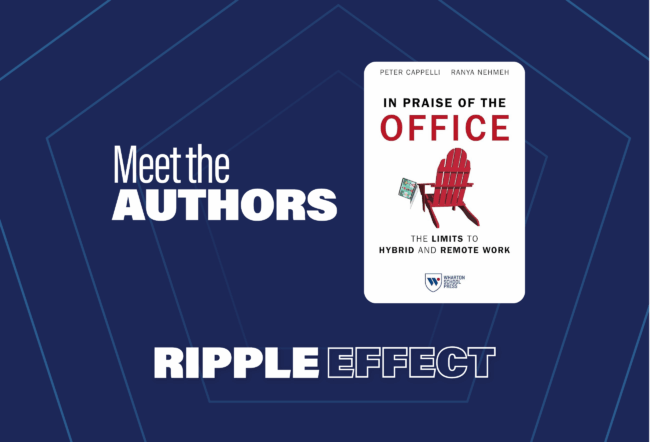At the Wharton-sponsored Future of Publishing conference held on April 30 in New York, one of the panels looked at the changing nature of content, specifically the increasing popularity of user-generated content spilling forth from an ever-growing variety of sources. The panel included Katharine Zaleski, executive producer and head of digital news products for The Washington Post and before that, senior editor in charge of special projects at The Huffington Post. Following her participation in the panel discussion, Zaleski spoke with Knowledge at Wharton about her role at The Washington Post, the importance of packaging stories, why news sites need to offer other people’s content, and what the future holds for investigative journalists, among other topics.
Knowledge at Wharton: I’m talking with Katherine Zaleski, executive producer and head of digital news products for The Washington Post. That is a title that probably wouldn’t have existed a few years ago.
Katherine Zaleski: A few months ago.
Knowledge at Wharton: Can you tell us what that title means and what you do?
Zaleski: I have this very interesting new role where I basically work very closely with the newsroom on everything from headline writing to story packaging to SEO practices.
Knowledge at Wharton: Please explain what SEO means.
Zaleski: Search Engine Optimization practices, which means writing headlines that make sense for search engines, getting the right key words into stories — things that are really essential to the business these days and will continue to be so. That is where my role as an educator [comes in], staying on top of what we do every day because I’m responsible for our traffic numbers and how many people we bring to the site — page views, engagement, etc.
So having that role — where I am responsible for a big part of growth — means that I also work with the business side. That is exciting because I get to use the knowledge on the business side to go out there and talk to companies that we should be partnering with, companies that are really going to help us enhance our journalism — social media companies. I also get to figure out ways that we should be packaging our journalism for the future.
Knowledge at Wharton: Is your background editorial or business?
Zaleski: I was the senior news editor at The Huffington Post. When I started there about five years ago, it was about [two weeks] after [the site] had launched. I was news editor. The company has grown tremendously since then, as we all know. I had a bifurcated role. I really focused on editorial but I had a front row seat to how the website grows, gets bigger, the central people to add, the deals that should be done. It was very exciting. It was probably the best education I could have had or will ever have.
Knowledge at Wharton: You made a comment at one point that there is no way that websites could aggregate information without The Washington Post, The New York Times, The Wall Street Journal, etc., and that even Bill O’Reilly [conservative commentator on the Fox news channel] wouldn’t be able to have a show that takes off after The New York Times if you weren’t there. So that led to a discussion of the fact that there are packagers and there are originators. You are trying to be an originator of new products at this time. Can you talk about that?
Zaleski: First of all, I think that the current world, where there are companies like Associated Content and Demand Media, is a fantastic world to be in because it allows people to have more access to information in more ways…. I don’t want to downplay at all the value of those companies and the value of social media and the value of even Fox News shows like Bill O’Reilly’s because they enhance journalism…. But people who originate great content — who really know how to develop a story, who have contacts in the middle of Pakistan, who can sense what’s coming next — that is something that takes years and years to develop. You can’t just get that out of social media or companies that have a completely freelance-based model. You need very seasoned editors who have been around for decades.
Knowledge at Wharton: The Washington Post is one of the great originators of content in the world today. But you do have a challenge as you noted, for instance, working with editors on headlines, working on how stories are packaged and presented. So there is that side to the business that is getting increasingly important. Is that something that you feel is going to get even more important and play a bigger role in journalism?
Zaleski: Yes, definitely. The thing is that a lot of people have the same content so it is really a fight for who can actually make that content look better, make it more engaging, bring in better tools to enhance it, have the best conversation around it, have the best comments around it. I’m not saying that everything that is on our site is original. That would be ridiculous to say. We have AP content out there. We are now linking to other sources [including] Politico, ABC, AOL. We understand that there are many places to get your news out there. We want people to not see us as just one source. I think that if we want people to come and stay on our site, we need to recognize that our content alone doesn’t take us to the level that we want to be at.
Knowledge at Wharton: You launched a product called Network News. What is that?
Zaleski: It is basically a Facebook iframe and it is something we worked on with Facebook on for about four months. It is available now to everybody.
Knowledge at Wharton: Designed to make the product more social?
Zaleski: Yes. The idea was that people were going to sites like Facebook and Twitter to get news and see what their friends are sharing. So why not bring that on to The Washington Post? Also, why not put a good chunk of real estate on our home page to recognize that people share news through their social networks and don’t want just news that is put up for them.
Knowledge at Wharton: There was a question from someone who said that she wants to read dense professionally-written stories. She is concerned about what she called the intense social surround sound — just too much information — too much interactive information perhaps. What is the challenge there? How can media companies figure out ways to handle so much intense conversation in such a way that people aren’t overwhelmed and that allows them to make discriminating judgments about what they want to read and take in and listen to?
Zaleski: I think we have a role in actually helping people with that by doing what we do best, which is editing and making sense of content. If we can do that with social media, there is a lot of value there. It would be a great service to me if someone could take all the best tech feeds out there and not just put them on the pages’ feeds, but really point out the best stuff. That’s hard. And I don’t think many institutions are actually set up to do it. But that’s what we do every day with the world. So why can’t we do that with social media?
Knowledge at Wharton: The site Politico.com, which apparently was started by Washington Post people. I guess one of the lessons learned from that is that you can’t publish once a day. There is no more, “What’s your deadline?” It’s no longer a relevant question. You, in fact, have changed The Post’s politics coverage with a new section launched called PostPolitics.com. That is a new model for you — putting other people’s political content on it besides Post reporters. That is quite a dramatic move. Was it a hard sell to the political reporters?
Zaleski: No. I wasn’t in the position to sell it to them. It was driven by the innovations editor for the politics team, a guy named Paul Volpe. And then it came very much from the senior editorial leadership that this was instrumental to our future: the fact that we have to recognize that if we want to be the place for politics — which we still are; we still get the most traffic in Washington — we needed to recognize that we ourselves can’t be all things to all people. But what we can do is we can edit and make sense of the universe that is out there. In order to do that we have to be more open, which is bringing in other people’s content.
Knowledge at Wharton: Another question was about the future of long-form content in the online space since there seems to be a tendency often to shorten things and dumb them down. How do you feel that is going to play out?
Zaleski: I think we might be confusing the fact that a piece doesn’t have to all be under the same URL. Something can be long-form. It just doesn’t have to all be published at the same moment or under the same heading. So there are ways to serialize content. I also talked about how there are tools out there — unfortunately we focused too much on the iPad during the talk but [there is also] the eReader, the Kindle — all those tools gives an opportunity to explore long-form in other venues.
Knowledge at Wharton: One of the speakers earlier this morning said that there are going to be fewer and fewer journalists and fewer and fewer investigative journalists — [and perhaps] political journalists — in the years to come. Do you agree with that? And if so, what are the implications of that?
Zaleski: I think if you are going to have investigative journalists and are really going to nurture them, you have to have patience for what they do. Stories take months — some say years — to develop. Once [an investigative piece or series of pieces] comes out, it can make an entire organization…. Publishers need to understand that…. I worry more about [this issue] from the publisher standpoint. If the focus isn’t there, then there is no capacity for the role.
Knowledge at Wharton: Thanks very much for talking with us.
Zaleski: Thank you.



